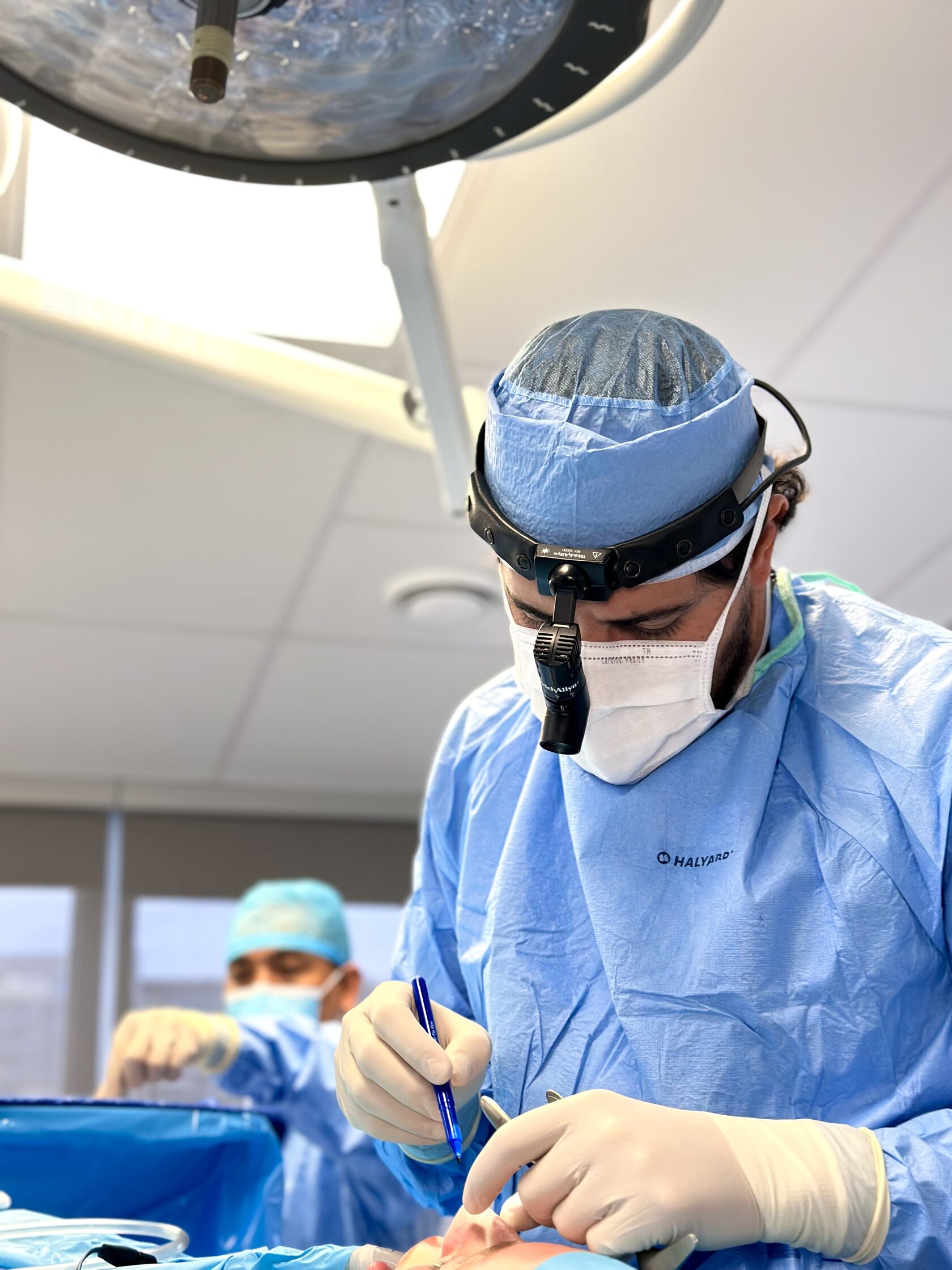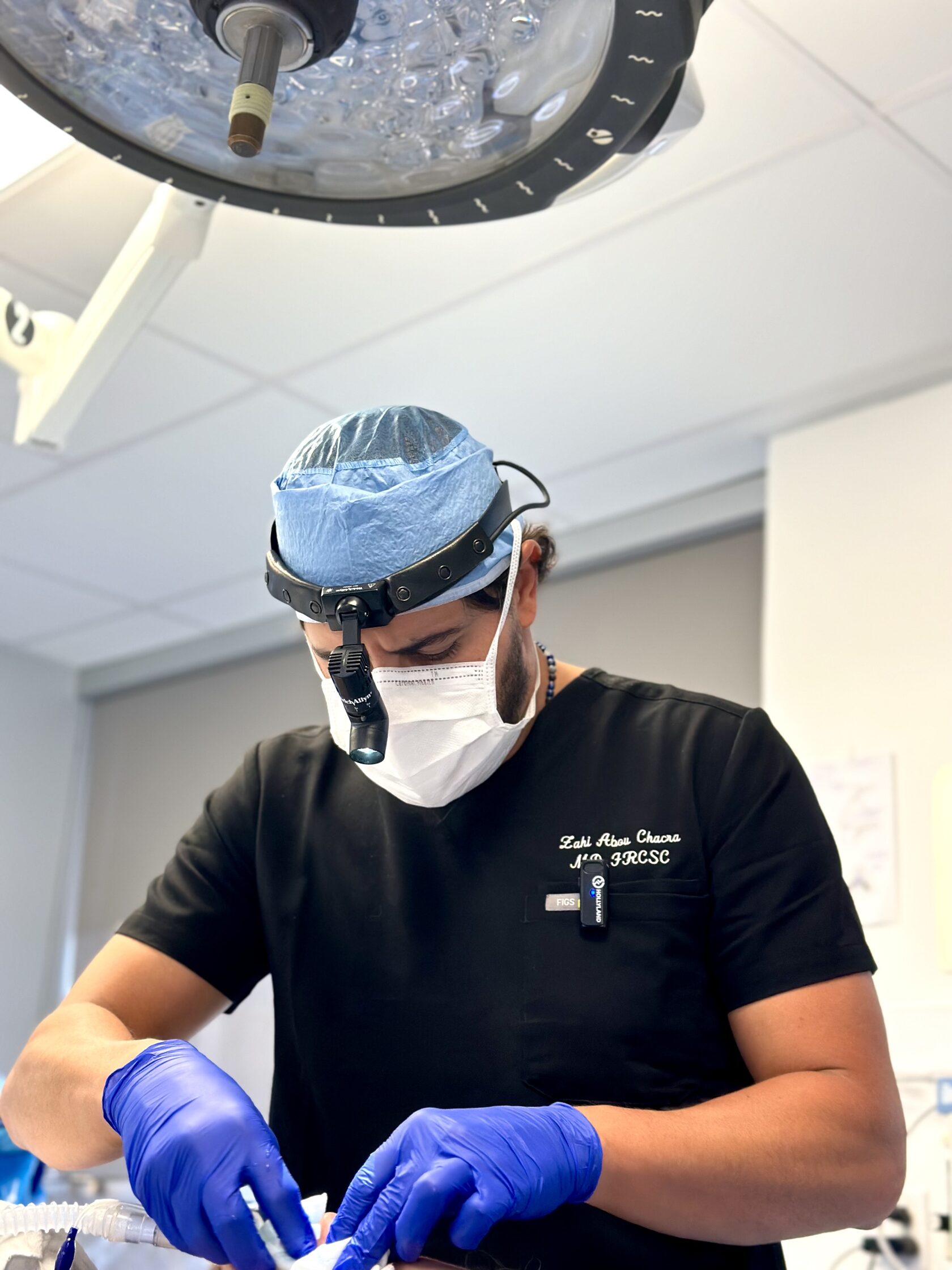OUR SERVICES
Boutique experience. Breathtaking results.
by Dr. Zahi Abou Chacra
Functional Rhinoplasty

FUNCTIONAL RHINOPLASTY AT A GLANCE
Functional Rhinoplasty differs from Cosmetic Rhinoplasty. The goal of this surgery is to alleviate nasal obstruction. While changes in the appearance of the nose is not the objective of this procedure, Functional Rhinoplasty can be combined with a Cosmetic Rhinoplasty, as often is the case. The goal of this combined surgery is then to improve upon both breathing, as well as aesthetics.
During a Functional Rhinoplasty, Dr. Chacra corrects nasal passages to improve his patients’ breathing by utilizing only the safest techniques.
During a Functional Rhinoplasty, Dr. Chacra corrects nasal passages to improve his patients’ breathing by utilizing only the safest techniques.
SEPTOPLASTY AT A GLANCE
Septoplasty is a surgical procedure designed to improve the patient’s breathing by straightening the wall inside the nose that divides the nasal passages into a right and a left side (nasal septum).
The nasal septum is a thin wall of hyaline cartilage and bone, which divides the nostrils. When the septum is not straight, airflow to the nose becomes disrupted and breathing difficulties may arise.
Septoplasty is often combined with Rhinoplasty. This maximizes the nasal airway after surgery and allows for improved breathing.
It is not uncommon for patients with deviations to choose to improve the look of their nose while undergoing Septoplasty. The result of Septo-Rhinoplasty is twofold: Patients experience enhanced breathing, as well as a softened, more balanced appearance.
The nasal septum is a thin wall of hyaline cartilage and bone, which divides the nostrils. When the septum is not straight, airflow to the nose becomes disrupted and breathing difficulties may arise.
Septoplasty is often combined with Rhinoplasty. This maximizes the nasal airway after surgery and allows for improved breathing.
It is not uncommon for patients with deviations to choose to improve the look of their nose while undergoing Septoplasty. The result of Septo-Rhinoplasty is twofold: Patients experience enhanced breathing, as well as a softened, more balanced appearance.
create your own block from scratch
Your nose
is in
Skilled Hands
Book a consultation



COSMETIC AND FUNCTIONAL RHINOPLASTY: WHAT’S THE DIFFERENCE?
Rhinoplasty is the name for a surgical procedure that changes the shape of the nose to achieve more balance and symmetry of the facial features. Rhinoplasty can also be performed using procedures to improve and treat the function of the nose by correcting obstructed breathing.
Dr. Chacra is a Functional Rhinoplasty Specialist, as well as a Cosmetic Rhinoplasty Specialist. Restoring patients’ breathing, correcting deviated a septum, and softening or creating a more structured nose are some of the reasons why patients choose Clinique 7 as their Premiere Destination for Rhinoplasty in Montreal.
The surgical techniques used during Rhinoplasty are among the most complex and detailed out of all facial procedures. Rhinoplasty is often regarded as one of the most difficult cosmetic procedures to perform. This is why it is important to choose a surgeon with the highest level of training, experience, and skill.
Dr Chacra is a renowned, double-board-certified Rhinoplasty Surgeon who is familiar with even the subtlest variations in his patients’ facial structures.
While some patients seek to undergo Rhinoplasty for reasons related to their appearance, others’ main goal is to improve the quality of their breathing.
Changes to appearance fall under the Cosmetic category, while adjustments to one’s breathing are considered Functional modifications. Dr. Chacra has extensive knowledge and experience in performing both types of surgeries, making him a true expert in Rhinoplasty. He has worked on incredibly complex and difficult cases, including trauma reconstruction. Due to his expertise, Dr. Chacra is often one of, if not the first choice for referring physicians in Montreal.
Someone from our team is available to discuss which of these procedures may be right for you. We also offer a nonsurgical option, known as Liquid Rhinoplasty.
Dr. Chacra is a Functional Rhinoplasty Specialist, as well as a Cosmetic Rhinoplasty Specialist. Restoring patients’ breathing, correcting deviated a septum, and softening or creating a more structured nose are some of the reasons why patients choose Clinique 7 as their Premiere Destination for Rhinoplasty in Montreal.
The surgical techniques used during Rhinoplasty are among the most complex and detailed out of all facial procedures. Rhinoplasty is often regarded as one of the most difficult cosmetic procedures to perform. This is why it is important to choose a surgeon with the highest level of training, experience, and skill.
Dr Chacra is a renowned, double-board-certified Rhinoplasty Surgeon who is familiar with even the subtlest variations in his patients’ facial structures.
While some patients seek to undergo Rhinoplasty for reasons related to their appearance, others’ main goal is to improve the quality of their breathing.
Changes to appearance fall under the Cosmetic category, while adjustments to one’s breathing are considered Functional modifications. Dr. Chacra has extensive knowledge and experience in performing both types of surgeries, making him a true expert in Rhinoplasty. He has worked on incredibly complex and difficult cases, including trauma reconstruction. Due to his expertise, Dr. Chacra is often one of, if not the first choice for referring physicians in Montreal.
Someone from our team is available to discuss which of these procedures may be right for you. We also offer a nonsurgical option, known as Liquid Rhinoplasty.
SEPTOPLASTY AND FUNCTIONAL RHINOPLASTY: WHAT’S THE DIFFERENCE?
Both of these surgeries aim to improve breathing function. During a Septoplasty, Dr. Chacra will only address the septum, whereas during a Functional Rhinoplasty, he sees to all other areas of the nose, as well.
The tendency is for Septoplasty to be performed over a Functional Rhinoplasty, as the latter is a more extensive surgery, usually only required for more complex cases involving complicated nasal obstruction.
When a Functional Rhinoplasty is performed, a Septoplasty is often combined. Thus, becoming what is known as Functional Septo-Rhinoplasty.
The tendency is for Septoplasty to be performed over a Functional Rhinoplasty, as the latter is a more extensive surgery, usually only required for more complex cases involving complicated nasal obstruction.
When a Functional Rhinoplasty is performed, a Septoplasty is often combined. Thus, becoming what is known as Functional Septo-Rhinoplasty.
NASAL OBSTRUCTION: WHAT ARE SOME COMMON CAUSES?
Anatomical variations
One or a combination of the following: Turbinate hypertrophy, septal deviation, and nasal valve incompetence (either external or internal nasal valve). Anatomical variations can be congenital (born with them), developmental (change as the nose grows), traumatic (from an accident) or iatrogenic (caused by another surgery).
Medical causes
However, there is a long list of medical causes of nasal obstruction that need to be ruled out during examination:
NASAL OBSTRUCTION: WHAT CAN BE CORRECTED SURGICALLY?
SEPTOPLASTY, FUNCTIONAL RHINOPLASTY OR TURBINATE REDUCTION: WHICH IS RIGHT FOR ME?
A thorough consultation, as well as a combination of various examination techniques are essential to pose an accurate anatomical diagnosis when it comes to nasal obstruction. Once the precise anatomical cause or causes are identified, Dr. Chacra will tailor either a combination of a Septoplasty, Functional Rhinoplasty and / or Turbinate Reduction. A standard static nasal exam is never sufficient to pose an accurate diagnosis.
Nasal Endoscopy (done in-office, on the day of your consultation) can help reveal regions of the nasal airway that are not visible with a standard nasal speculum exam.
Dynamic observation of the nasal valves while the patient is breathing (inspiration) is equally important, as this hints to the potential specific location and extent of a nasal valve’s incompetence.
Manipulation and analysis of the nasal valves during inspiration allows Dr. Chacra to evaluate the potential success of a Functional surgery.
One or a combination of the following: Turbinate hypertrophy, septal deviation, and nasal valve incompetence (either external or internal nasal valve). Anatomical variations can be congenital (born with them), developmental (change as the nose grows), traumatic (from an accident) or iatrogenic (caused by another surgery).
Medical causes
However, there is a long list of medical causes of nasal obstruction that need to be ruled out during examination:
- Nasal allergies
- Sinusitis
- Nasal polyps
- Benign or malignant masses
NASAL OBSTRUCTION: WHAT CAN BE CORRECTED SURGICALLY?
- Hypertrophied turbinates on the internal sides of the nose (Turbinectomy)
- Deviated nasal septum (Septoplasty)
- Internal nasal valve (Functional Rhinoplasty)
- External nasal valve (Functional Rhinoplasty)
SEPTOPLASTY, FUNCTIONAL RHINOPLASTY OR TURBINATE REDUCTION: WHICH IS RIGHT FOR ME?
A thorough consultation, as well as a combination of various examination techniques are essential to pose an accurate anatomical diagnosis when it comes to nasal obstruction. Once the precise anatomical cause or causes are identified, Dr. Chacra will tailor either a combination of a Septoplasty, Functional Rhinoplasty and / or Turbinate Reduction. A standard static nasal exam is never sufficient to pose an accurate diagnosis.
Nasal Endoscopy (done in-office, on the day of your consultation) can help reveal regions of the nasal airway that are not visible with a standard nasal speculum exam.
Dynamic observation of the nasal valves while the patient is breathing (inspiration) is equally important, as this hints to the potential specific location and extent of a nasal valve’s incompetence.
Manipulation and analysis of the nasal valves during inspiration allows Dr. Chacra to evaluate the potential success of a Functional surgery.

Contact Us
